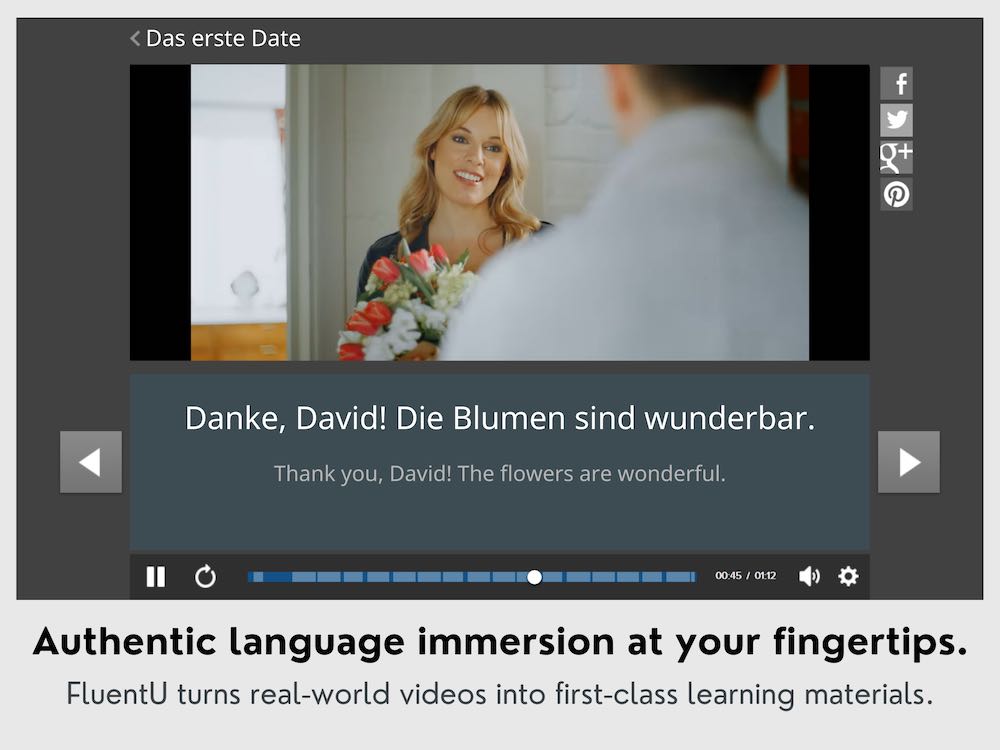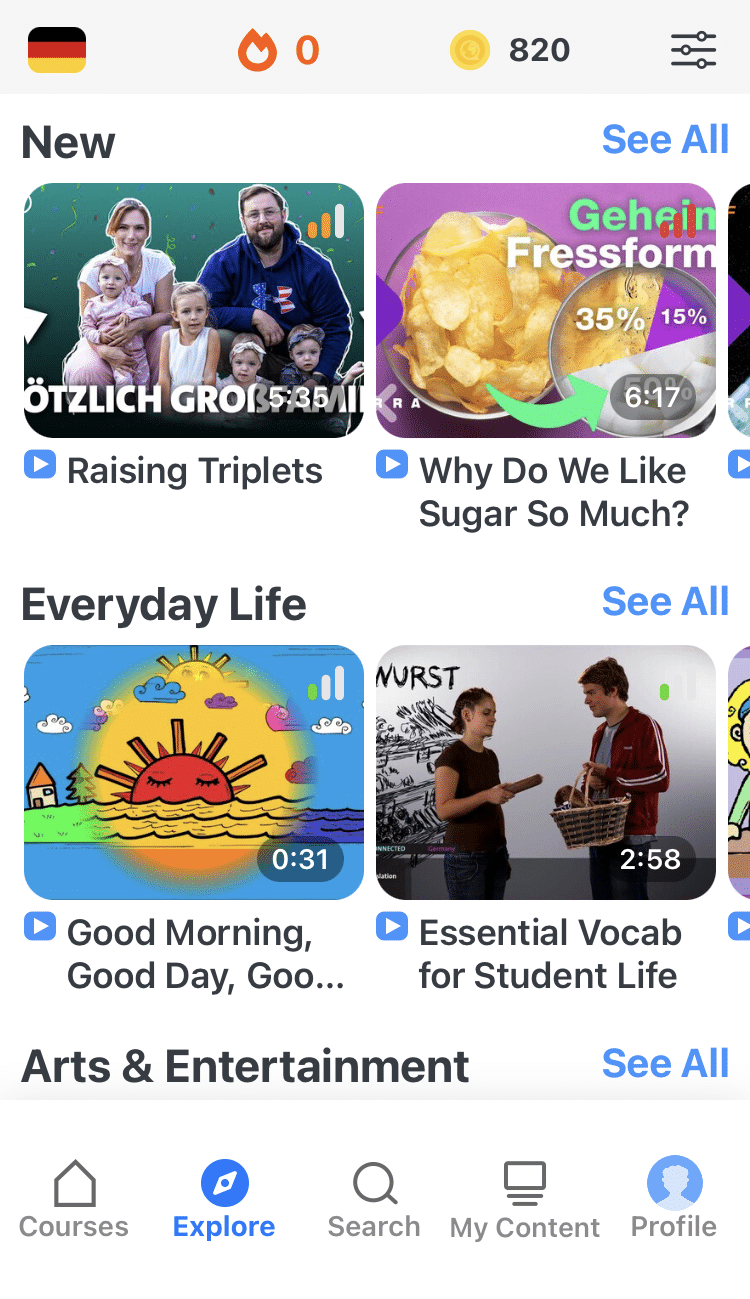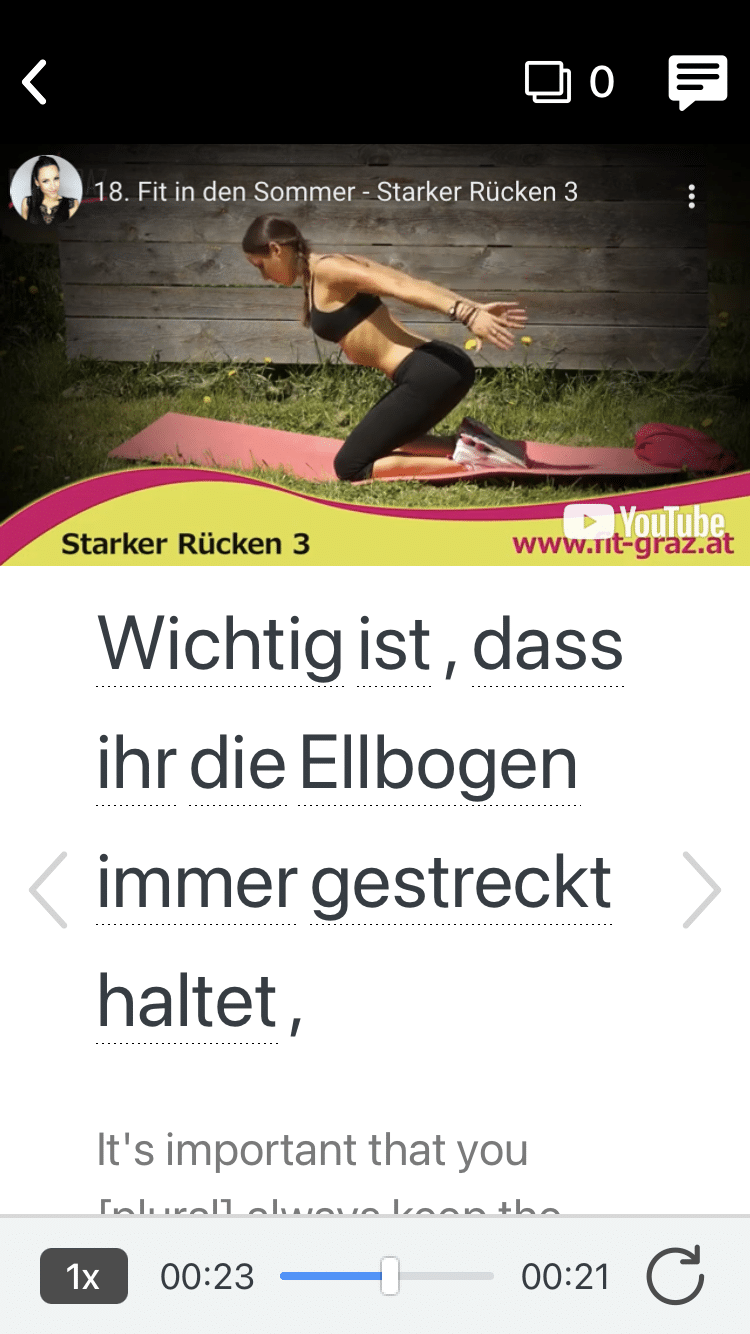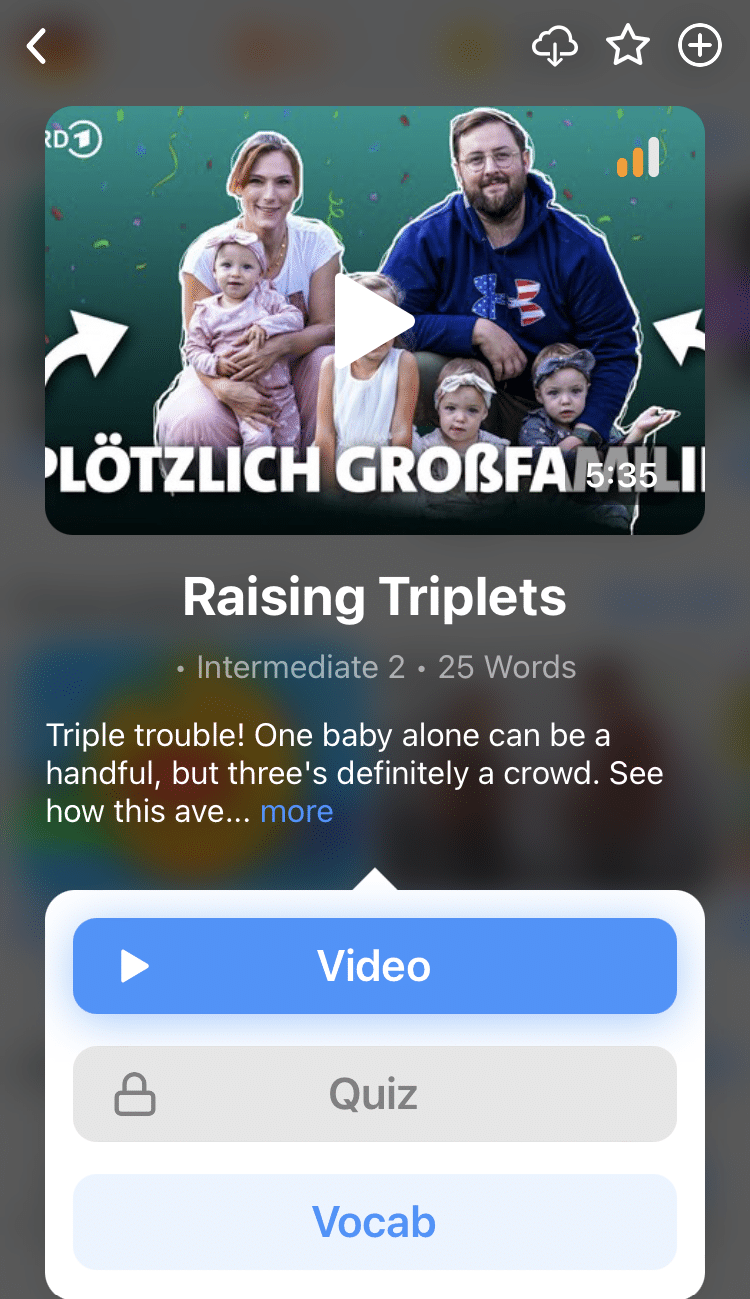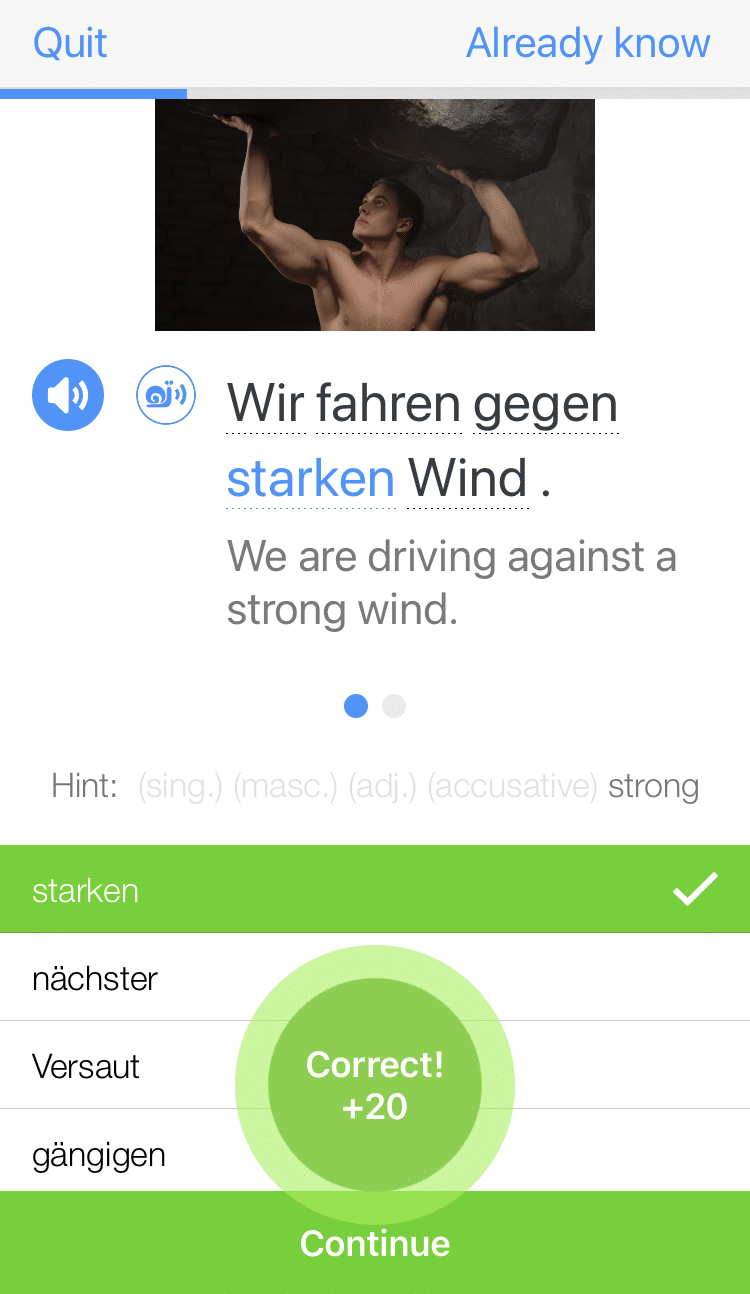
The 27 Best German YouTube Channels for Learners in 2024
YouTube is filled with amazing ways to learn German and enjoy yourself at the same time.
In this post, we’ve compiled a list of the 27 best German YouTube channels which will provide you with quality learning experiences and top-notch entertainment.
You’ll be improving your language skills in no time!
Contents
- German YouTube Channels for Language Learning
- German Language Learning Through Animation
- German Culture and Life in Germany
- German YouTube Shows
- Why Use German YouTube Channels for Learning?
- How to Use German YouTube Channels for Learning
- And One More Thing...
Download: This blog post is available as a convenient and portable PDF that you can take anywhere. Click here to get a copy. (Download)
German YouTube Channels for Language Learning
1. lingoni GERMAN
lingoni GERMAN is hosted by Jenny, who speaks both English and German natively. Because of this, she’s uniquely equipped to help native English speakers learn the German language.
One of the best things about this channel is that it offers comprehensive playlists of nearly 450 videos taking learners from the A1 (beginner) to B2 (high intermediate) level.
The videos focus on grammar skills, vocabulary and listening comprehension exercises specific to each level, and there are some videos for general interest content and vlogs in German.
2. GermanPod101
Fast, easy and fun. That’s the German language learning experience promised by GermanPod101’s YouTube channel, and it certainly does its best to live up to those aims.
One of the neat aspects of the channel is that GermanPod101 likes to mix it up a bit with a variety of formats. Some videos feature a presenter on camera while others rely on just pictures and audio.
Language students will find the German listening practice videos particularly useful. Each one presents dialogue and questions in German, which you have to respond to in German.
FluentU takes authentic videos—like music videos, movie trailers, news and inspiring talks—and turns them into personalized language learning lessons.
You can try FluentU for free for 2 weeks. Check out the website or download the iOS app or Android app.
P.S. Click here to take advantage of our current sale! (Expires at the end of this month.)
3. Learn German with Herr Antrim
As a native English speaker and language teacher, Herr Antrim’s channel was created for his students, but contains a wealth of material for anyone starting out on their German language adventure.
Herr Antrim explains language topics with a whiteboard and detailed grammar explanations, which is perfect for those who prefer classroom-style learning.
There are also cute or funny graphics, puppets and example conversations which will help you learn the language in an even more entertaining way.
4. Deutsch mit Marija
Deutsch mit Marija (German with Marija) is a YouTube channel created by Marija, a Latvian-turned-German teacher who helps students prepare for proficiency tests in German.
While all learners of German will find useful content, Deutsch mit Marija creates content predominantly in German. As such, it’s recommended that learners have a B1 level in the language or higher.
Video topics oscillate between tackling German grammar points and vocabulary explanations to lifestyle topics such as work, learning and productivity.
5. fröhlich Deutsch
Are you having trouble losing your accent? Struggling to nail proper pronunciation of those few German letters?
Michaela’s channel offers tips on how to improve your German pronunciation and the lessons are taught in German, so you’re bound to be getting a lot of learning and practice.
When it comes to speaking German, learners can fall into plenty of traps that can bungle up what they want to say. She talks about how you can avoid the common problem areas so that you can communicate with confidence.
6. Business Deutsch mit Vasilena Petkova
Vasilena Petkova offers tips and strategies for both native and non-native speakers to help them create better first impressions for employment.
Although matters related to business can be intimidating or dry, Vasilena has a friendly approach that can put you at ease. Plus, she speaks at a measured and patient pace, so you won’t have much trouble following her.
Also, if you ever catch one of Vasilena’s occasional live streams, you can hop in to chat or ask questions (in German, naturally)!
7. Learn German with Anja
Learn German with Anja is a very popular YouTube channel for learning German. The videos are a mix of languages, which means that each video has content in both English and German.
With a few grammar videos for beginner and low-intermediate learners, Anja has videos on German expressions, common mistakes and words that you should know to sound more like a native speaker.
In addition to videos aimed at teaching a specific vocabulary or grammar topic, there are also short listening comprehension topics spoken in slow, clear German.
8. Deutsch für Euch
Self-confessed language nerd Katja from southern Germany is on a mission to teach people German and take the stuffiness out of learning languages.
In most of the videos, Katja talks directly to the camera and teaches German and about German culture with the help of her perfect English.
She has a friendly disposition and always seems to be smiling, which draws in viewers and makes the lessons more palatable. This is particularly important when she tackles tricky areas such as German articles.
9. Get Germanized
Students of German can hone their language skills to a tee by watching Get Germanized. The videos are aimed at all levels—from beginners to experts—and are produced and presented by a native German speaker.
Dominik started the channel to boost his English skills, but the community and his ambition have both grown. In addition to language learning, there are many insights into Germany and German culture.
He also covers all the basics such as pronunciation, numbers and lessons about individual letters. Check out his playlist with over 200 videos on learning German.
10. German with VlogDave
A newer addition to the German learning community, Dave studied German and its many intricacies at university. As a result, he’s a natural teacher.
He teaches German through Rammstein song lyrics, TV shows, movies, video games and travel vlogs. There are also videos on slang and expressions, and he even has a podcast.
Some of his videos are entirely in German with English subtitles, while others are in English with German vocabulary included.
11. DontTrustTheRabbit
Trixi, the creator of DontTrustTheRabbit, offers fun and easy German lessons presented in English. If you ever had some specific questions, Trixi may have talked about it in one of her videos!
Much of her content offers a quick list of context-dependent terminology or phrases. She also offers some information about social situations and typical German behavior.
She breaks down the language and looks at dialects, colloquialisms and verbs, highlighting the underappreciated beauty of the language.
German Language Learning Through Animation
12. Hallo Deutschschule
This is an animated channel that mainly focuses on vocabulary and grammar. Many videos have scripted dialogues and scenarios to give you a background context.
To make sure that learners can follow along, the narration is quite slow and the phrases are repeated often. To get some extra practice, you should repeat out loud what’s being said. There are also English subtitles.
The channel also includes the appropriate learner level for its videos, so you can easily pick out which ones suit you. It uploads a new video every Sunday, so you can slip the newest lesson into your schedule for that day!
13. Deutsch Verstehen
Deutsch Verstehen (Understanding German) is another animated channel. Many of these videos are dialogues or short stories focusing on various topics relevant to beginner and intermediate German learners.
The videos are completely in German with German transcripts as speech bubbles or descriptions on the screen. English subtitles and translations can be toggled on and off using YouTube’s caption feature.
Many of the videos focus on topics surrounding everyday life, work, love and school. In addition to the animated videos, there are also German grammar lessons.
14. Learn German
Learn German is a practical, no-nonsense channel that offers lots of short animated videos where a teacher goes through phrases and grammar and drills pronunciation with you.
The teachers on Learn German explain the grammar and use of the vocabulary very clearly in English. There are videos for all levels and they cover a wide range of topics, including daily life topics.
You’ll expand your vocabulary and become aware of the difference between formal and informal verb forms, which is crucial for actually talking in German.
15. My German Short Stories
This is a YouTube channel that features original short stories by its creator, Sherin. The stories are written in German and recited in YouTube videos with accompanying images and an on-screen transcript.
The vocabulary and grammatical structures are simple enough that they’re perfect for intermediate learners and higher, and the stories themselves are told in slow, clear German.
Viewers who support the channel on Patreon are also able to download supplementary materials for each short story such as downloadable transcripts, vocabulary exercises and story audio files.
16. Uwe Kind & LingoTech
When my professor introduced the video about prepositions from Uwe Kind & LingoTech to us during lecture, the class practically erupted in laughter, but thanks to this song, we’ll never forget the two-way prepositions.
Die Wechselpräpositionen (the two-way prepositions) were certainly difficult for me to remember in my first year of German. This particular set of prepositions can be used in both the Akkusativ and Dativ cases, and without some sort of method, it’s tricky to remember which ones they are.
German Culture and Life in Germany
17. Easy German
An offshoot of the Easy Languages channel, Easy German has come up with a wonderful format for teaching German—go out in the street and speak to actual Germans!
You, the listener, benefit from hearing real German spoken at normal speeds by native speakers. Don’t worry if you’re a beginner because the videos are supported by both German and English subtitles.
By being out and about on the streets, these German learning videos keep things fresh, giving the viewer lots of interesting visuals and glimpses into life in Germany.
18. Slow German
This podcast turned YouTube channel features Annik speaking slowly in German about a variety of topics that relate to German culture.
If you’re a beginner learner or working to improve your listening comprehension skills, Annik’s videos can be a great help. They’re quite short in length and Annik practices great intonation to make sure you’re getting all the unique German sounds.
More of her recent videos show Annik narrating, so you watch these videos so you can observe and mimic Annik as she speaks.
19. Feli from Germany
Feli is originally from Germany and moved to the US a few years ago where she now lives. She documents the differences between American and German culture, and her life in the US as a German.
Feli explains cultural differences, such as national holidays, food, the education system and more. She busts various stereotypes and also confirms that some of the German stereotypes are true!
There are occasional language learning videos and tips on learning German, but if you’d like to experience two countries through the eyes of a German person, this is the channel for you.
20. DW Deutsch
Deutsche Welle is one of the biggest news organizations in Germany. Primarily, Deutsche Welle’s YouTube channel is updated with topical news content.
The videos focus on short clips about trending current events happening in Germany, Europe and the world. They also upload longer documentaries, and many of them have captions in German or translations in English.
It also runs “Deutsch lernen mit der DW” (Learn German with the DW), a sister YouTube channel that focuses on its German-learning offerings. Many of these videos correspond to their German-language courses, available on their website.
German YouTube Shows
21. Nicos Weg
Nicos Weg: Einfach Deutsch lernen (Nico’s Way: Easy German Learning) is a German language learning series on YouTube created by Deutsche Welle.
Nicos Weg is a professional production, not just one teacher talking in his or her living room. It covers three complete levels, from A1 (beginner) to B1 (lower intermediate), and each course includes 50 to 75 individual lessons.
Each lesson targets a specific German language topic or vocabulary theme. There is also extra learning material in the the description of each video, such as vocabulary, grammar explanations and exercises.
22. Gute Arbeit Originals
Gute Arbeit Originals (Good Work Originals) produces hilarious skits that are sure to add a humorous tinge to the German you learn.
While the contexts are comedic and absurd, the use of the German language is quite natural in both vocabulary and tone, so you’ll be hearing a lot of familiar phrases and vocabulary.
Although the videos themselves are fully in the German language, the channel acknowledges its non-native audience, and offers plenty of videos with English titles, descriptions and subtitles!
23. MrWissen2go
MrWissen2go is a YouTube channel that gives history, politics and current events a pop spin. Since the channel is aimed at native German speakers, all of MrWissen2go’s videos are completely in German.
Created by Mirko Drotschmann, MrWissen2go’s videos are focused on current happenings and they often include commentary by Drotschmann himself as well as occasional guests.
In addition to its main channel, MrWissen2go also has a sister channel that focuses on various historical odd topics such as pirates, hip pop, the samurai and more.
24. Life to Go
Instead of focusing on the family, children and everyday life, this channel follows two German travelers, Daniel and Jessica. In fact, these two have been on their world trip since 2015!
The majority of their videos focus on vlogs from their numerous trips around the world. Additionally, a number of them focus on the practical considerations of traveling long-term, such as tips for specific places.
Like other native German channels, Life to Go is completely in German, and their videos are without official German captions and English subtitles.
25. Dinge Erklärt
You probably already know about the hit channel Kurzgesagt. But did you hear about its German cousin Dinge Erklärt (Things Explained)? It offers some of the same, brilliantly animated, but the narration is entirely in German.
Each clip offers thought-provoking information on all kinds of topics, including but not limited to historical events, philosophical debates and looming existential questions.
Even better, subtitles are also provided! These will be pretty helpful since the vocabulary can get a bit more technical or advanced.
26. Leeroy will’s wissen!
Leeroy conducts casual, candid interviews with all kinds of folks. His roster includes people who’ve undergone certain experiences, some of which are quite unique or curious.
He’s a great interviewer and transitions fluidly from what was last said, providing an honest but informative profile of his guests. One of the best points about the videos is Leeroy’s genuine curiosity.
He also gives his interviewees the time and space to speak without pause. This means that whatever German you pick up will be flavored with unique, interesting context.
27. Ultralativ
This channel is great if you’re interested in web culture and the YouTube platform. Ultralativ posts short video essays that mainly focus on YouTube culture and the internet.
The channel originally centered on certain YouTubers and their questionable antics, but the content has since broadened in scope to include general media analysis.
The narrator is quite witty, makes fun references and has plenty of opinions to share. He also doesn’t speak too quickly and has clear enunciation.
Why Use German YouTube Channels for Learning?
There are so many great reasons why you need to start using YouTube for your German right now.
- It’s completely free. It won’t cost you a dime to log in and start checking out all the various language-based videos. It works out a whole lot cheaper than buying German textbooks and taking language courses.
- It’s quick and easy. Pepper your day with short German language YouTube videos here and there. Take five and 10 minutes breaks from work and study time to procrastinate with these German videos for language learners.
- You have a huge selection of videos. Not in the mood for tenses and prepositions? No problem! YouTube offers you a great variety for when you need a break from grammar and boring classes.
- It helps with visual learning. Seeing a German TV show (which provides the context for new words and phrases) helps you retain the language better. It attaches a visual element to the learning process that can help it stick in the brain.
- Listen to German being spoken at a normal conversational speed. Native speakers from across Germany will be uploading their videos and showing off their different accents and dialects, so this gives you plenty of practice listening to different accents.
- Immerse yourself in authentic content. YouTube is brimming with authentic German materials, like news reports or clips from German TV shows. You can also watch some German YouTubers do a spicy noodle challenge or a video from a German travel vlogger!
- Become part of a community. Some creators interact with their followers on a regular basis. While you may not be face-to-face, these people you’ve never met come to feel like friends. Plus you can ask questions in the comments and other language learners like yourself might help you out!
How to Use German YouTube Channels for Learning
- Learn your CEFR level. While studying German, you’ve no doubt came across these letter-number combinations. A1 refers to absolute beginners and C2 refers to advanced learners, comparable with native speakers. Don’t know your level? Take an online German level test to find out.
- Decide how much time you have to spend. Too busy at work? A video under 10 minutes may be just what you need. Do you have nothing to do over the summer or are you getting ready for that trip of a lifetime to Berlin? Maybe longer, more intensive lessons are the way to go.
- Actively watch and listen. You should have a pen and paper with you whenever you’re studying. Pay attention to key points and make sure to write down any examples that the speaker gives, just like you would in a classroom. Don’t space out while you watch!
- Repeat and review. The beautiful part about studying with videos is that if you do miss something or need to go over it again, you can just rewind. Watching one video two or three times in a row is a good way to really get everything out of it and make sure you haven’t missed anything important.
- Use subtitles. Firstly, watch the video through once without them turned on. Then write down everything that you understood. Watch the video a second time with the subtitles turned on. You can then use them to fill in any gaps in your understanding. You can also write down any words you don’t understand in a notebook.
- Practice, practice, practice! Since your short-term memory is stronger but more fleeting, practicing what you’ve learned from a video as soon as you’re done watching it can help you set those language skills into your long-term memory. It can also smooth out any kinks or confusion that you might have.
- Be consistent. This is key in your learning to ensure you make the progress you want and need. Once you decide on why you’re learning German and are on a roll with learning, make sure that you actually stick with it so that you can continue to improve.
With all of these great videos to watch, you’ll have no trouble finding something that fits what you’re looking for. You’ll be on your way to German fluency in no time!
Download: This blog post is available as a convenient and portable PDF that you can take anywhere. Click here to get a copy. (Download)
And One More Thing...
Want to know the key to learning German effectively?
It's using the right content and tools, like FluentU has to offer! Browse hundreds of videos, take endless quizzes and master the German language faster than you've ever imagine!
Watching a fun video, but having trouble understanding it? FluentU brings native videos within reach with interactive subtitles.
You can tap on any word to look it up instantly. Every definition has examples that have been written to help you understand how the word is used. If you see an interesting word you don't know, you can add it to a vocabulary list.
And FluentU isn't just for watching videos. It's a complete platform for learning. It's designed to effectively teach you all the vocabulary from any video. Swipe left or right to see more examples of the word you're on.
The best part is that FluentU keeps track of the vocabulary that you're learning, and gives you extra practice with difficult words. It'll even remind you when it’s time to review what you’ve learned.
Start using the FluentU website on your computer or tablet or, better yet, download the FluentU app from the iTunes or Google Play store. Click here to take advantage of our current sale! (Expires at the end of this month.)
